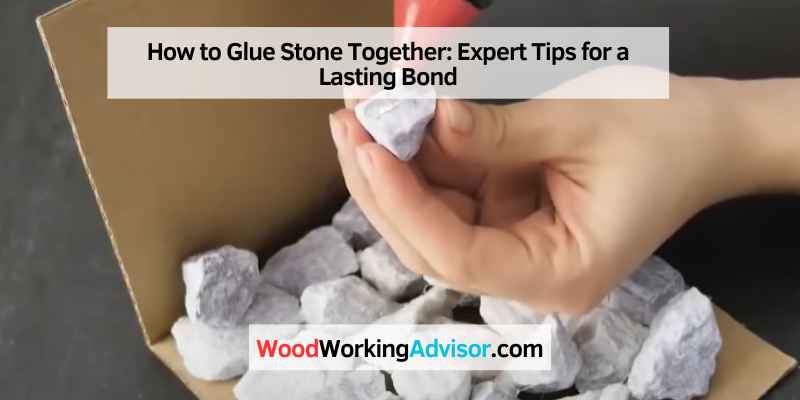To glue stone together, apply a strong adhesive designed for bonding stone surfaces, such as epoxy or construction adhesive, following the manufacturer’s instructions. Ensure that the surfaces are clean, dry, and free of dust or debris before applying the adhesive.
If you have ever encountered a broken stone sculpture or a damaged stone countertop, you know the importance of finding a reliable solution to glue the stones back together. Gluing stone together might seem like a challenging task, but with the right adhesive and proper technique, you can restore its original form and strength.
We will guide you on how to effectively glue stone together, ensuring a durable and long-lasting bond. Whether you are dealing with granite, marble, or other stone materials, these techniques will help you repair and preserve your valuable stone pieces. So, let’s explore the methods and precautions involved in effectively gluing stone together.
Selecting The Right Glue
When it comes to gluing stone together, selecting the right glue is crucial for a strong and long-lasting bond. Different types of glue work better for different types of stone, and understanding the porosity of the stone is also important to ensure proper adhesion. In this section, we will explore these factors in detail to help you make the right choice.
Consider The Type Of Stone
Before starting any gluing project, it’s important to consider the type of stone you are working with. Not all glues are suitable for all types of stone, so it’s essential to choose a glue that is specifically formulated for the type of stone you are working with. Here are some common types of stone and the corresponding glues that work well with them:
| Type of Stone | Recommended Glue |
|---|---|
| Marble | Marble adhesive or epoxy-based glue |
| Granite | Epoxy-based adhesive |
| Slate | Stone-specific adhesive or epoxy-based glue |
Choosing the right glue for your specific type of stone will ensure that the bond is strong and durable. It is always a good idea to consult the manufacturer’s recommendations or seek professional advice if you are unsure about which glue to use.
Assess The Porosity Of The Stone
Another important factor to consider when selecting the right glue for stone is the porosity of the stone. Porosity refers to how easily the stone absorbs liquids or substances. Some stones have high porosity, while others have low porosity.
If you are working with a porous stone, such as limestone or sandstone, it’s important to choose a glue that can penetrate the pores of the stone and create a strong bond. Epoxy-based adhesives are often a good choice for porous stones as they can seep into the pores and create a secure connection.
On the other hand, if you are working with a non-porous stone, such as granite or marble, a glue that dries quickly and bonds well to smooth surfaces is ideal. These types of stones may require a specialized stone adhesive or epoxy-based glue that is formulated to adhere to smooth and non-porous surfaces.
By assessing the porosity of the stone, you can select a glue that is specifically designed to work well with the stone’s unique characteristics. This will ensure that the bond is strong and resistant to wear and tear.
When it comes to gluing stone together, selecting the right glue for the job is essential. Consider the type of stone you are working with and assess its porosity to determine the best glue for your project. Using the appropriate glue will help you achieve a strong and durable bond that will withstand the test of time.

Preparing The Surface
Before bonding stones together with glue, it’s essential to properly prepare the surface. Following these steps will help ensure a strong and long-lasting bond:
Clean The Stone Surfaces
The first step in preparing the surface is to clean the stone surfaces thoroughly. Use a soft brush or cloth to remove any dirt, dust, or debris from the stones. This will help the glue adhere better to the surface and provide a tight bond. Additionally, make sure to remove any loose or flaking material from the stones to ensure a smooth and even bonding surface.
Ensure Proper Dryness
After cleaning the stones, the next step is to ensure that they are completely dry before applying the glue. Moisture can interfere with the bonding process and weaken the adhesive. Place the stones in a well-ventilated area and allow them to air dry naturally. Avoid using any artificial means to speed up the drying process, as this may affect the integrity of the stones or create moisture on the surface.
When the stones are completely dry, you can proceed with the gluing process. This will help to ensure a strong bond and increase the durability of the stone structure.
Applying The Glue
Applying the glue when working with stone is a crucial step in ensuring a strong and durable bond. The technique and precision used in this phase can make all the difference in the final result of your project. In this section, we will discuss the key aspects of applying the glue to effectively and securely join stone together.
Use The Right Amount Of Glue
Ensure that you use the appropriate amount of glue when bonding the stones together. Using too little may result in a weak bond, while using too much can create a messy and uneven application. It’s important to follow the manufacturer’s guidelines for the specific type of adhesive to achieve the optimal bond strength.
Apply Even Pressure
When applying the glue, it’s essential to exert even pressure on the stones to ensure a secure bond. This can be achieved by using clamps or weights to hold the pieces together while the adhesive sets. Additionally, applying consistent pressure helps to minimize air gaps and ensures that the glue spreads evenly across the surfaces, enhancing the overall strength of the bond.
Allowing For Proper Drying
Properly allowing for the drying process is crucial when it comes to gluing stones together. This step ensures a solid bond and prevents any movement or shifting that could weaken the joint over time. By following a few key tips, you can ensure that your stone adhesive has ample time to dry and create a strong, long-lasting bond.
Follow Manufacturer’s Recommendations
When it comes to drying time, it’s important to follow the specific instructions provided by the manufacturer of your stone adhesive. Different types of adhesives may have varying drying times, depending on factors such as humidity and temperature. By following the manufacturer’s recommendations, you can ensure that the adhesive dries properly and achieves maximum strength.
Avoid Disturbing The Bond
Once you’ve applied the adhesive and positioned the stones, it’s crucial to avoid disturbing the bond during the drying process. Any movement or stress applied to the stones can compromise the adhesive’s effectiveness and lead to a weak joint. To prevent this, try to keep the stones undisturbed and secure them in place using clamps or tape if necessary.
To avoid affecting the drying process, it’s also important to refrain from applying any additional weight or pressure to the stones until the adhesive has completely cured. This will ensure that the bond remains intact and strong.
By following these simple guidelines, you can allow for proper drying of your stone adhesive and ensure a strong and durable bond between the stones. Taking the time to let the adhesive cure fully will give you the confidence that your glued stone project will stand the test of time.
Ensuring A Strong Bond
When it comes to gluing stones together, achieving a strong bond is crucial. Whether you’re working on a DIY project or repairing a valuable stone structure, you need the knowledge and techniques to ensure a secure connection. In this section, we’ll explore two essential factors for ensuring a strong bond: performing a test bond and proper care and maintenance.
Performing A Test Bond
A test bond is a crucial step before permanently gluing stones together. It allows you to evaluate the compatibility of the adhesive and the stones, ensuring a strong and lasting bond:
- Select your adhesive: Choose an adhesive suitable for the type of stones you are working with. Epoxy-based adhesives are commonly used for their superior strength and durability.
- Create a test surface: Use spare or broken stones to create a test surface. Make sure the stones are clean and free from any debris or contaminants.
- Apply adhesive: Follow the manufacturer’s instructions to apply the adhesive on both surfaces. Make sure to apply an even layer, covering the entire bonding area.
- Join the surfaces: Press the stones together firmly, aligning them accurately. Apply consistent pressure for the recommended curing time.
- Evaluate the bond: After the curing time, carefully inspect the bond. Check for any signs of weakness, such as gaps or loose stones. If the bond is strong and reliable, you can proceed with confidence.
Proper Care And Maintenance
Ensuring a strong bond isn’t just about the initial gluing process. Proper care and maintenance are essential to maintain the integrity of the bond over time. Here are some tips to help you achieve a long-lasting connection:
- Keep the surface clean: Regularly clean the bonded area, removing dirt, dust, and other contaminants. This prevents the accumulation of debris that can weaken the bond.
- Avoid extreme temperature changes: Rapid temperature changes can cause stones to expand or contract, potentially weakening the bond. Avoid exposing the bonded area to extreme heat or cold.
- Protect from water damage: If your project is exposed to moisture or water, ensure proper sealing to prevent water infiltration. Moisture can compromise the bond and lead to structural failure.
- Monitor for signs of deterioration: Regularly inspect the bonded area for any signs of deterioration, such as cracks, chips, or movement. Promptly address any issues to prevent further damage.
- Seek professional assistance: If you’re unsure about the care and maintenance requirements of your specific stone project, it’s always wise to consult with professionals who have expertise in stonework.

Frequently Asked Questions On How To Glue Stone Together
What Glue Works On Stone?
An epoxy or construction adhesive works well for bonding stone. Make sure to clean and dry the surfaces before applying the glue. Epoxy works great for small repairs, while construction adhesive is better for larger projects. Always follow the manufacturer’s instructions for best results.
What Is The Best Way To Glue Rocks Together?
The best way to glue rocks together is by using a strong and durable adhesive specifically designed for bonding stones. Apply the adhesive evenly to both surfaces, press the rocks together firmly, and let it dry for the recommended time.
Ensure surfaces are clean and dry before applying the adhesive for better results.
How Do You Glue Natural Stone Together?
To glue natural stone together, follow these 5 steps:
1. Clean the stone surfaces to remove dirt and debris.
2. Choose a strong adhesive suitable for stone, such as epoxy or construction adhesive.
3. Apply the adhesive evenly on both surfaces to be glued together.
4. Press the stone pieces together firmly, ensuring a tight bond.
5. Allow ample drying time for the adhesive to set and cure completely.
Will Gorilla Glue Work On Stone?
Yes, Gorilla Glue will work on stone as it bonds strongly to various materials, including stone.
Conclusion
Gluing stone together requires the right adhesive and proper surface preparation. By following the steps outlined in this guide, you can ensure a successful bonding process for your stone projects. From selecting the right adhesive to applying it effectively, these tips will help you achieve strong and durable results.
Happy gluing!


